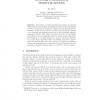Free Online Productivity Tools
i2Speak
i2Symbol
i2OCR
iTex2Img
iWeb2Print
iWeb2Shot
i2Type
iPdf2Split
iPdf2Merge
i2Bopomofo
i2Arabic
i2Style
i2Image
i2PDF
iLatex2Rtf
Sci2ools
145
Voted
COCOON
2010
Springer
2010
Springer
On Sorting Permutations by Double-Cut-and-Joins
The problem of sorting permutations by double-cut-and-joins (SBD) arises when we perform the double-cut-and-join (DCJ) operations on pairs of unichromosomal genomes without the gene strandedness information. In this paper we show it is a NP-hard problem by reduction to an equivalent previously-known problem, called breakpoint graph decomposition (BGD), which calls for a largest collection of edge-disjoint alternating cycles in a breakpoint graph. To obtain a better approximation algorithm for the SBD problem, we made a suitable modification to Lin and Jiang’s algorithm which was initially proposed to approximate the BGD problem, and then carried out a rigorous performance analysis via fractional linear programming. The approximation ratio thus achieved for the SBD problem is 17 12
Related Content
| Added | 24 Jan 2011 |
| Updated | 24 Jan 2011 |
| Type | Journal |
| Year | 2010 |
| Where | COCOON |
| Authors | Xin Chen |
Comments (0)

